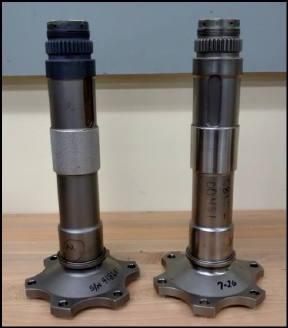


Measurement demonstration component provided by Corpus Christi Army Depot (CCAD)
Interest in Laser Powder Feed Directed Energy Deposition (LPFDED) repaired components has grown, but it is still a maturing technology. This project focuses on the development of a LPFDED repair technology that can be cost-effectively and consistently applied to a wide range of high-reliability applications with a certifiable, approval-based method.
Problem
There is a need for a reliable and robust additive manufacturing (AM) repair method for military aircraft related components manufactured from Ti-6Al-4V. Depending on the component, conventional repair methods may not always be feasible or reliable. As a result, interest in Laser Powder Directed Energy Deposition (LPDED) to solve this problem has grown. LPDED is a maturing technology, however, lacking specifications, best practices, procedures, and process controls.
Objective
The goal of this project was to facilitate the adoption of AM for flight-worthy repairs by restoring the Ti-6Al-4V component function without compromising structural integrity. Restoration of the component function was achieved by the development of an LPDED repair methodology that could be cost-effective and consistently applied to a range of applications. The project also included the coordinated integration of available, past and ongoing, LPDED development efforts into a centralized directed energy database (DEDatabase).
Technical Approach
This project consisted of four phases to develop LPDED for certifiable component repair and maintenance:
- Formation Phase – Established a DEDatabase structure and performed a gap analysis based on prior investigations, along with Air Force repair requirements.
- Development Phase – Demonstrated and refined all appropriate repair capabilities down-selected from candidate technologies.
- Testing Phase – Designed and executed a metallographic and mechanical testing program to generate design data for generic U.S. Department of Defense (DoD) repair configurations utilizing the down-selected capabilities.
- Documentation and Deployment Phase – Populated the DEDatabase with accumulated process data and results, and summarized the LPDED repair process best practices for distribution to America Makes stakeholders.
Accomplishments
The team collaborated with DoD branch repair Depots, OEMs, supply chains, and technical societies to identify best practices for comparable Ti-6Al-4V repair methods currently in use and approved for military aircraft engine applications. Corpus Christi Army Depot (CCAD) provided a shaft that helped the team develop and demonstrate part measurement protocols for general application to LPDED repairs.
The team also investigated and adopted commercial additive component build and repair methods for Ti-6Al-4V currently in use and approved for commercial aircraft engine applications. Upon gathering and consolidating best practices and “pedigreed” methods and data for commercial applications, a consensus was reached and progress made towards identifying and satisfying military air worthiness qualification requirements and data for LPDED repairs of DoD additive components.
The DEDatabase was populated and integrated with a data management system for additive manufacturing (DMSAM) for access by America Makes members and stakeholders. The DEDatabase along with the significant elements related to best practices and specification guidelines enables greater adoption of this technology.
Milestone Video
Project Participants
Project Principal

Other Project Participants
- Pennsylvania State University ARL (PSU ARL)
- Concurrent Technologies Corporation (CTC)
- United Technologies Research Corporation (UTRC)
- Connecticut Center for Advanced Technology
- University of Connecticut
- Corpus Christi Army Depot (CCAD)
- TechSolve
- GE Aviation
- Lockheed Martin
- Rolls Royce Corporation
- EWI
Public Participants
- Air Force Research Laboratory (AFRL) Materials and Manufacturing Directorate, Manufacturing and Industrial Base Technology Division
